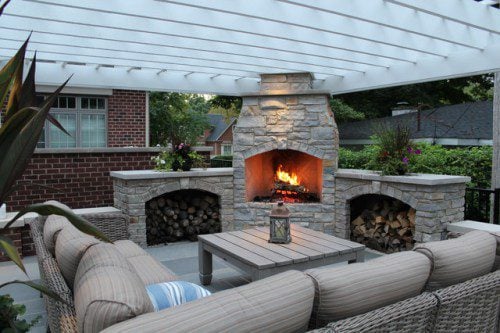The weather may not be the most conducive right now to start thinking about adding an outdoor fireplace to your property, but just like any other project you are considering for your landscape and home, it’s important to put a bit of thought and planning into it before you break ground or spend money.
Here are some tips for you to help you get started with your outdoor fireplace project.
-Be sure to thoroughly investigate local building codes and regulations.
Because wood-burning fireplaces can generate a lot of smoke, it is important to ensure you are meeting all of your local building codes and regulations for adding an outdoor fireplace. In some areas, building codes may require that chimney height for a wood burning outdoor fireplace be two feet taller than any adjacent structures on a piece of property. You also need to be sure that the size of the flue and chimney allow for the smoke to vent upward and out and don’t create downdrafts.
Needless to say, there are many safety considerations and regulations that you need to be sure are being met when you embark upon your outdoor fireplace project. Also, while gas fireplaces may not require a chimney, they do need a vent pipe and gas line. So be sure everything is in place and in order before proceeding to ensure the safety of your family and your neighbors.
-Make sure you are situating your new outdoor fireplace in the best location for your property. You’ll enjoy your fireplace more if it is easily accessible to your house, pool, hot tub, or other outdoor recreation areas. Your guests and family will also appreciate having a fireplace nearby after they get out of the water.
-Choosing the right size for your outdoor fireplace depends upon how you plan to use the fireplace, and the amount of space you have to work with. If you plan on entertaining large groups of people, then you might want to consider a fireplace with an extended hearth to allow for more seating.
Outdoor fireplaces can range in size, starting at 3 feet wide by 2 feet deep and 4 feet tall, and going up from there. The size ultimately depends upon your budget, needs, and the amount of outdoor space available.
-When considering which materials to use when you are building your fireplace, there are a lot of options. Brick, different types of stone, concrete and stucco are all great possibilities. Stucco is usually the least expensive option. You can also choose brick veneer or facebrick, which comes in a variety of colors and textures.
If you wish to save some time when building your outdoor fireplace, concrete fireplaces can take half as much time to build as stone.
-When choosing which fuel you are going to burn in your outdoor fireplace, you have a number of options. A wood burning or propane fireplace can be built anywhere in your backyard, as these are usually freestanding structures without any need to connect to utilities.
Wood burning fireplaces are cheaper to operate than gas, but could require a chimney that is large or tall enough to provide adequate drafting and meet local building codes. A gas fireplace requires a gas line, proper set up and venting.
-Be sure you are situating your fireplace in a location on your property with good drainage. Whether you get a lot of snow, rain or ice, your fireplace needs to have a way to drain out to prevent damage.




